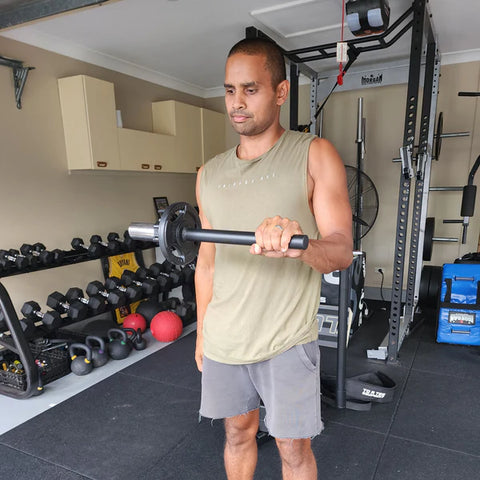
Innovative Uses for the Wrist Bar: Enhance Your Wrist Strength and Flexibility
Explore six innovative exercises using the Wrist Bar to enhance your wrist strength, flexibility,...
If you’ve ever rolled your ankle, struggled with balance, or felt stiff through your calves or Achilles, you already know how much weak or immobile ankles can affect your performance.
Strong, mobile ankles don’t just protect you from injury - they improve your power, movement efficiency, and even your knee and hip health.
Here’s how to start building bulletproof ankles.
Your ankle joint is the first link in the kinetic chain. When it moves well, everything above it — knees, hips, spine — follows suit. When it doesn’t, your body compensates elsewhere, which can lead to poor movement patterns and pain.
Lack of ankle dorsiflexion (the ability to bring your knee over your toes) is one of the most common restrictions I see. It limits depth in squats, affects sprinting mechanics, and increases stress on the knees.
The goal? Ankles that are both mobile enough to move freely and stable enough to handle load.
Mobility isn’t just about flexibility. You can stretch your calves all day, but if you’re not strengthening through that range, you won’t see lasting results. This is where slant boards and slant blocks come in.
Try slant board squats or Poliquin step-ups — both help open up the ankle joint and strengthen your quads through deeper ranges of motion. The elevation lets your knees travel forward safely, teaching your ankles to move under control.
Tip: Use slower tempos or pauses at the bottom to build control and stability.
Most people only train their calves — the muscles that push the foot down. But your tibialis anterior, the muscle running along the front of your shin, is equally important.
Using a Tib Bar, you can load ankle dorsiflexion directly, strengthening the front of the lower leg.
This not only helps prevent shin splints but also boosts your ankle’s ability to absorb force — key for running, jumping, and cutting in sport.
Start with 3 sets of 10–15 reps, focusing on smooth control both up and down.
Once mobility and front-side strength are in check, it’s time to train functionally.
Using a sled waist strap, perform backward walks or drags. These target the quads and tibialis while building stability through the ankles and knees. It’s a fantastic low-impact conditioning tool that reinforces strong, aligned movement patterns.
Think of it as strength training for your joints, not just your muscles.
Finish your sessions with slant board calf raises and single-leg balance drills.
Calf raises build resilience in the Achilles tendon and strengthen the lower leg for explosive movement. Balance work — like standing on one leg with eyes closed or on an unstable surface — trains your ankles to react quickly, reducing the risk of sprains.
Bulletproof ankles aren’t built overnight, but with the right tools and consistency, you’ll move better, lift stronger, and reduce your risk of lower-limb injuries. Start small: add one or two ankle-focused exercises into your warm-up or finishers each week. Over time, you’ll notice better control, smoother movement, and stronger performance across the board.
Train smart. Build from the ground up.